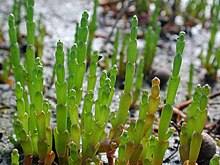Salicornioideae
| Salicornioideae | |
|---|---|
 |
|
| Salicornia europaea | |
| Scientific classification | |
| Kingdom: | Plantae |
| (unranked): | Angiosperms |
| (unranked): | Eudicots |
| (unranked): | Core eudicots |
| Order: | Caryophyllales |
| Family: | Amaranthaceae |
| Subfamily: |
Salicornioideae Ulbr. |
| Genera | |
|
About 11 genera, see text |
|
About 11 genera, see text
The Salicornioideae are a subfamily of the flowering plant family Amaranthaceae (sensu lato, including the Chenopodiaceae). Important characters are succulent, often articulated stems, strongly reduced leaves, and flowers aggregated in thick, dense spike-shaped thyrses. These halophytic plants are distributed worldwide.
The Salicornioideae are annual or perennial herbs, subshrubs, or low shrubs. Their stems are glabrous and often apparently jointed. The alternate or opposite leaves are fleshy, glabrous, often basally connate and stem-clasping (thus forming the joints), with missing or short free leaf blades.
The spike-shaped inflorescences consist of alternate or opposite bracts, these are often connate and stem-clasping, sometimes free. In the axil of each bract, there are one to five (rarely to twelve) flowers, free or sometimes fused to each other, to the bract, and to the inflorescence axis. The flowers are usually bisexual (the lateral flowers may be unisexual). The 2-5-lobed perianth consists of two to five connate tepals. There are one or two stamens and an ovary with mostly two stigmas.
In fruiting phase, the perianth remains membranous or becomes spongy, crustaceous, or horny. The fruit wall (pericarp) may be membranous, fleshy, chartaceous, crustaceous, woody, or horny. The seed is disc-shaped, lenticular, ovoid or wedge-shaped. Its surface may be smooth, papillose, reticulate, tuberculate or longitudinally ribbed. The embryo is curved, half-annular or horseshoe-shaped, rarely only slightly curved. In most genera, the seed contains copious perisperm, but a feeding tissue is missing in Salicornia and Sarcocornia.
The majority of the Salicornieae species are C3-plants. There is only one species that has developed C4-photosynthesis, Tecticornia indica (syn. Halosarcia indica).
...
Wikipedia
